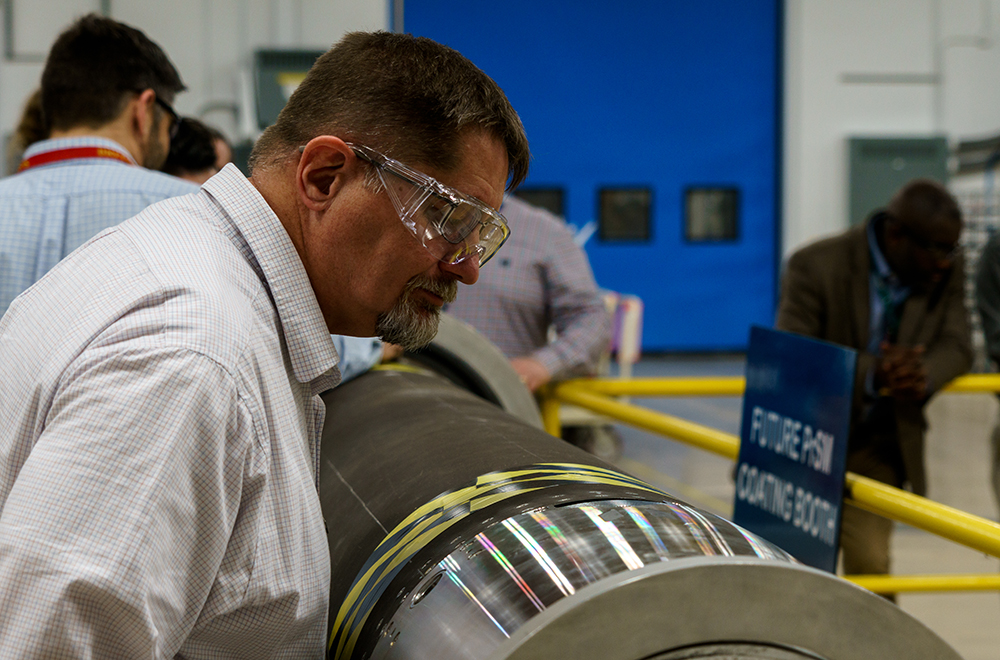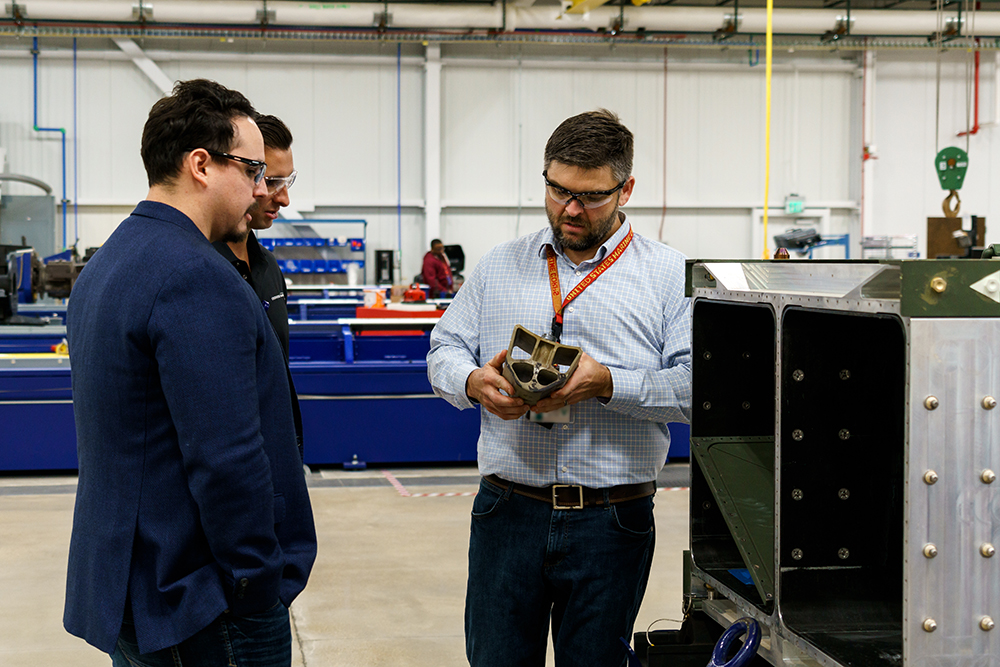
ASSEMBLY REQUIRED: The STORM, Defense Contract Management Agency and Lockheed Martin teams gather around a missile-assembly fixture during the tour of the facility. Pictured, from left, are STORM quality analyst Valerie Parks, Lockheed Martin production planning and control manager Derek Jones, Lockheed Martin production planning and control representative PJ Munoz, Lockheed Martin Dallas manufacturing engineer Michael Sweeney, Lockheed Martin Camden Operations engineer Keith Cutchall, Lockheed Martin Dallas manufacturing engineer Aaron Sosa, STORM production engineer Linda Fechner, Lockheed Martin Dallas production operations manager Matt Hartley, and Lockheed Martin Camden manufacturing engineer Colton Moore. (Photo courtesy of Lockheed Martin)
A culmination of efforts brings the Army one step closer to delivering PRSM to the warfighter.
by Kinsey Lindstrom
In the last two years, the U.S. Army’s Precision Strike Missile (PRSM) program successfully accomplished numerous flight tests, pushing the next-generation munition to the edge of its range and proving its long-range capability. And while PRSM has been testing its limits in the sky, the Army has been simultaneously conducting critical, on-the-ground system qualification tests and manufacturing-readiness assessments.
Addressing the Army’s top modernization priority, long-range precision fires, PRSM is the Army’s new surface-to-surface missile that replaces and improves upon the Army Tactical Missile System’s capabilities. The new missile will defeat threat air defense, missile launchers, command-and-control centers, assembly and staging areas, and high-payoff targets at all possible depths of the multidomain battlefield. By 2023, the Army will deliver the first lot of PRSM missiles to the warfighter.
To replace the legacy munition, the PRSM program requires the Army to design, build and produce this new technology from the ground up. However, before PRSM can be delivered to the Soldier, the manufacturing facilities must undergo scrupulous reviews to ensure missile assembly and production are ready for operation.
In early March, the U.S. Army Strategic and Operational Rockets and Missiles (STORM) Project Office and Defense Contract Management Agency conducted the final PRSM enhanced-technology maturation and risk reduction system manufacturing-readiness assessment at the Lockheed Martin production facility in Camden, Arkansas. The manufacturing-readiness assessment defines the current level of manufacturing maturity, identifies any shortfalls and associated costs and risks and provides a basis for management of manufacturing-maturation planning of the program.

TESTING THE LIMITS: The next-generation PRSM launches from the HIMARS during the U.S. Army’s fourth consecutive flight test on May 12, 2021 in a 400-kilometer demonstration at White Sands Missile Range (WSMR), New Mexico. (Photo courtesy of WSMR)
GROUND-LEVEL TESTING
The March (2022) system manufacturing-readiness assessment was a culmination of a yearlong team effort between the STORM Project Office and the prime contractor. The manufacturing-readiness assessment team reviewed objective evidence in support of a Manufacturing-Readiness Level 7, which identifies the capability to produce the PRSM systems, subsystems and components in a production-representative environment.
To achieve that level, the production facility demonstrated how it will operate, not only when assembling prototypes, but also during production of the actual fielded tactical missiles. The team discussed manufacturing planning early, while ensuring the necessary resources will be in place to support future production needs of the program. Some of the manufacturing-readiness areas included technology and industrial base, design, cost and funding, materials, process capability and controls, quality management, workforce, and facilities and manufacturing management.
“The event proved to be a critical asset to the ongoing success of PRSM production, providing an early opportunity to address manufacturing risks as well as planning appropriate mitigation steps,” said Linda Fechner of the assessment. Fechner is the STORM PRSM production lead engineer who spearheaded the manufacturing-readiness assessment efforts. “The team was able to define the current level of manufacturing maturity, identify roadblocks and provide a basis for maturing the overall manufacturing of the PRSM system.”

TOUR DU JOUR: Alvin Gracie, engineering production division chief for the U.S. Army STORM Project Office, tours the Lockheed Martin Camden Launcher Integration Center and the new Long Range Precision Fires building with his teammates, gaining a hands-on perspective of the PRSM missile assembly and final production. Also pictured are Jay Cossentine and Linda Fechner. (Photo courtesy of Lockheed Martin)
The team also identified action items and developed a maturation plan to address any anticipated manufacturing challenges and ways to overcome those potential obstacles. That plan is currently in motion and will continue to be monitored to closure throughout the program’s progression, ensuring future production needs are in place and on schedule.
Leading up to the March manufacturing-readiness assessment event, the Army and contractor teams conducted 10 pilot-line validations as well as seven manufacturing-readiness assessments with the major PRSM subcontractors. A pilot line is a pre-production assembly line that produces a small volume of new technology to help test out the product’s capability to perform in its final operating environment. The pilot-line validations verified subcontractor pilot production lines for PRSM subassemblies such as the warhead, rocket motor and guidance set. The subcontractors demonstrated that their pilot production lines were equipped, confirming they could build production-representative qualification hardware. The team conducted the manufacturing-readiness assessments to review objective evidence in support of a more rigorous Manufacturing-Readiness Level 8 event.
The higher manufacturing-level criteria require demonstration of the pilot line capability to prove it is ready for low-rate initial production of the PRSM missile. These criteria will be fully assessed in the upcoming engineering and manufacturing development phase of the program. Some of the biggest hurdles toward achieving that level are validating all pilot production lines for Lockheed Martin and their subcontractors as well as completing qualification testing. Another criteria for Manufacturing Readiness Level 8 is achieving all system level qualification testing to demonstrate a Technology Readiness Level 8.
During the final manufacturing-readiness assessment, the team toured the Lockheed Martin Camden Launcher Integration Center, as well as the new long-range fires production building. The PRSM missile container, known as the enclosure-assembly launch pod, will be built at the integration center along with future PRSM missile assembly. The facility is structured as an open and modular floor plan to support future process design and product development.
“The Army is one step closer to delivering PRSM to the warfighter,” said Craig Bergquist, PRSM product director for the STORM Project Office. “The opportunity to visit the facility where PRSM final missile assembly will take place is a culmination of the incredible efforts being accomplished across the Army and among our industry partners.”

INVESTIGATING THE INNER WORKINGS: Jay Cossentine, STORM Precision Strike Missile systems engineer, investigates the inner workings of the missile Control Actuation System while visiting the PRSM assembly facility. (Photo courtesy of Lockheed Martin)
SHIFTING FOCUS
With the enhanced-technology maturation and risk-reduction manufacturing-readiness assessment now complete, the Army is currently working to complete objectives for the PRSM engineering and manufacturing development contract and Early Operational Capability 1 effort, which will include system qualification and manufacturing readiness activities culminating in a fully qualified system. The fast-tracked PRSM program is shifting its focus from subassembly qualification to missile assembly qualification.
“PRSM has accelerated activities typically reserved for the [engineering and manufacturing development] phase into the [enhanced-technology maturation risk-reduction] phase in support of fielding the missile to the Soldier in [fiscal year] ‘23,” said Fechner. “Since the timeframe to qualify and field PRSM is so condensed, it is crucial that the Army assesses manufacturing readiness early to ensure a successful transition from development to production and fielding.”
The PRSM manufacturing assessments will continue during engineering and manufacturing development, preparing the program for the next hybrid acquisition phase, Milestone C and full-rate production. The engineering and manufacturing development assessments will have a Manufacturing-Readiness Level 8 requirement to demonstrate the prime contractor and subcontractors’ pilot-line capabilities and prove their readiness to begin early operational capability production.
Before to moving into Milestone C and full-rate production, engineering and manufacturing development production-representative missiles will be built and tested to finalize PRSM’s design. The Army is planning for those missiles to be the same design configuration as the first lot of early operational capability munitions that will be first delivered and fielded to the warfighter.
PRSM is slated to fly again in 2023 during the engineering and manufacturing development production qualification test series. These flight tests will fully qualify the system and confirm that the design meets required performance and technical specifications. The tests will also verify both the M142 High Mobility Artillery Rocket System and M270A2 Multiple Launch Rocket System capabilities to launch PRSM.

DESIGN DISCUSSIONS: Industry teammates discuss the forward sabot design and fabrication. The sabots aid in keeping the missile aligned as it exits the launch pod. From left, Michael Sweeney and Aaron Sosa, Lockheed Martin Dallas manufacturing engineers, and Lockheed Martin production planning and control manager Derek Jones. (Photo courtesy of Lockheed Martin)
CONCLUSION
“Test like you fly” is a well-known principal that emphasizes the importance of ground testing and simulation and how these objectives should accurately reflect the program’s long-term goals. As part of the Army’s No. 1 tactical modernization priority of long-range precision fires, the PRSM program is doing just that, proving out its success both on the ground and in the air.
The program’s incremental successes, though, are only achieved through a diverse team made up of dedicated Army leadership and user groups, software and mechanical engineers, acquisition and cost analysts, and a broad range of other collaborative teammates from within the Army and among industry partners. Military, civilian and contractor personnel are developing this cutting-edge technology and rapidly equipping the Soldier for the joint all-domain battlefield.
For more information, go to https://www.msl.army.mil/Pages/STORM/default.html.
KINSEY LINDSTROM provides strategic communications for the U.S. Army Program Executive Office for Missiles and Space, Strategic and Operational Rockets and Missiles (STORM) Project Office, at Redstone Arsenal, Alabama. With more than 12 years of writing and communications experience, she holds a B.A. in communication and information sciences with a concentration in public relations. She has written for local and national publications spanning the defense, finance, journalism, nonprofit and outdoor industries.







